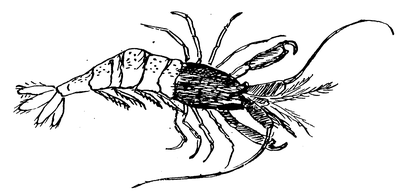the Lobster is by no means common, although some miles northward, and again in the vicinity of Lowestoft, it is a not uncommon take. Have occasionally seen fair-sized specimens brought in by shrimpers. Two, one a very fine one, captured in the Roads in one net, June 15th, 1897. Enormous specimens are occasionally landed from fishing smacks, covered with barnacles and zoophytes. A specimen weighing 10½ lb. is preserved in the town. Boxes of Lobsters, covered with Fucus serratus, sent by rail from Cromer are sold on the fish-wharf.
Nephrops norvegicus. Norway Lobster. A.—I am inclined to give this species a locus standi, having met with examples "almost alive" in the stomachs of locally-taken Cods. The digestion of Crustacea takes place most rapidly in the Cod's maw, the extremities becoming dissolved and gelatinous in a marvellously short space of time. The finding of perfect untouched examples is pretty fair proof of the recent capture of both devourer and victim. Very rarely does this species appear on our fishmongers' slabs, so that as an article of food it is not generally known. It becomes frequent "nor'ard of the Dogger." I have not yet secured a specimen from the shrimpers.
Crangon vulgaris. Sand Shrimp. A.—Literally teems on the coast; most abundant in summer time. Very large specimens appear to frequent the shallow waters, as may be seen in the one or two solitary shove-nets now rarely used from the shore. With Pandalus annulicornis it gives a living to a large number of "catchers" and their families, and provides food for multitudes of shore-loving fishes. Is found near shore even in winter, although it is a rare thing for a "catcher" to go out

